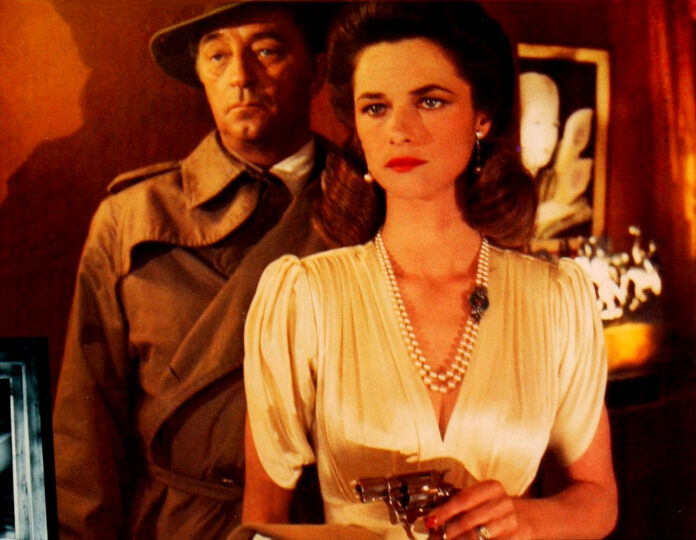To date, there have been eight attempts at bringing Raymond Chandler’s iconic private detective Philip Marlowe to the big screen, and only two of them have been keepers, Howard Hawks’ The Big Sleep (1946), with Humphrey Bogart as Marlowe, and Dick Richards’ Farewell, My Lovely (1975), with Robert Mitchum in the role. The Big Sleep has been available on home video for decades. Still, it wasn’t until last month, more than 40 years after its theatrical release, that Farewell, My Lovely was finally given an authorized DVD release (by Shout! Factory). Just in time, too. It’s the perfect stocking stuffer for the film noir fanatic on your holiday gift list.
That’s because Farewell, My Lovely was Richards’ affectionate Valentine to the film noirs of the 1940s. A serious, faithful Valentine, not a spoof (like those unfunny 70s “comedies” The Black Bird and Neil Simon’s The Cheap Detective) nor a post-modern deconstruction of the genre (like Robert Altman’s The Long Goodbye, Roman Polanski’s Chinatown, and Arthur Penn’s Night Moves). As he explained it to me, Richards was determined to recreate the feel of the original film noirs from the first decade of the genre. (Albeit with Technicolor prints and relaxed censorship.) Richards was kind enough to allow me to interview him in connection with this article, which was fortunate because my online research yielded precious little information about the making of this film. (And what few factoids I found turned out to be false. More about those later.)
If Sir Arthur Conan Doyle’s Sherlock Holmes provided the DNA from which all subsequent fictional British detectives descended, Chandler’s Marlowe was its American equivalent. By his own admission, Chandler wasn’t the first writer to create believable detective fiction for pulp magazines that owed nothing to the British drawing room mysteries popularized by Agatha Christie and Dorothy Sayers; Dashiell Hammett got there first. As Chandler memorably put it in his celebrated essay The Simple Art of Murder: “Hammett took murder out of the Venetian vase and dropped it into the alley… Hammett gave murder back to the kind of people that commit it for a reason, not just to provide a corpse; and with the means at hand, not hand-wrought dueling pistols, curare, and tropical fish. He put these people down on paper as they were, and he made them talk and think in the language they customarily used for these purposes.”
Although Philip Marlowe is basically an idealization of what a heroic private detective should be, with his honesty, integrity, and well-defined code of honor (one that Chandler gladly admitted was a fantasy of his own imagination), it doesn’t change the fact that Marlowe is the mold that all subsequent fictional American detectives have been set from. Ross MacDonald’s Lew Archer and John D. MacDonald’s Travis McGee were particularly influenced by Marlowe, even down to the first-person narration peppered with wisecracks and wry observations about modern society.

The character of Marlowe creates the biggest challenge for filmmakers trying to do justice to Chandler’s stories on the screen. While some of the other actors who attempted the role, such as Dick Powell, Robert Montgomery, James Garner, and Elliott Gould, had considerable acting chops, they still fell short of the standard set by Bogart and Mitchum. It’s not enough for an actor to be able to be convincing as a tough guy with a flair for flippancy to play Marlowe; most importantly, the actor has to exude an unmistakable sense of melancholy as Marlowe, one based on a longing for a better world without greed, fear, or corruption, a world where the rich and powerful aren’t free to ruin the lives of others who are defenseless against them. More than any of the other would-be Marlowes, Bogart, and Mitchum embodied that tarnished idealism. Richards said, “I’ve always said that Chandler had somebody like Mitchum in mind when he wrote Farewell. Tough guys at that time in film noir weren’t defined by muscles. They had ways of being tough and muscles wasn’t one of them… There was a certain melancholy they endured that gave them a reason for being a tough guy.”
The other main difficulty in adapting Chandler’s books for the screen is the incredible complexity of his plots. His convoluted plotting owed no little thanks to the fact that his first four novels were mash-ups of elements from the short stories he wrote at the start of his pulp career. (The reason that Hawks’ film version of The Big Sleep is so notorious for its confusing storyline is due mainly to a combination of plot elements changed or eliminated in accordance with the censorship code, Hawks’ own disregard for story exposition, and one infamous mistake on Chandler’s part.) Once again, by his own admission, Chandler simply didn’t care about story construction or who did what to whom. As he said, “I don’t care whether the mystery is fairly obvious but I do care about the people, about this strange, corrupt world we live in, and how any man who tries to be honest looks either sentimental or just plain foolish.”
But whatever shortcomings Chandler may have had in constructing his plots, he more than made up for them with his genius for writing dialogue. As an American with a classical education from Dulwich College in London, Chandler was a frustrated would-be poet who was drawn to pulp mystery fiction by the creative uses of slang he found in them. In a 1949 letter to Canadian journalist Alex Barris, Chandler explained his fascination with the language of the pulps: “[W]hen I use slang, colloquialisms, snide talk, or any kind of off-beat language, I do it deliberately. The literary use of slang is a study in itself. I’ve found that there are only two kinds that are any good: slang that has established itself in the language, and slang that you make up yourself.”

Even filmmaker Billy Wilder, who was certainly no slouch when it came to writing dialogue himself, credited Chandler with coming up with the best lines in their screenplay for Wilder’s 1944 film adaptation of James M. Cain’s Double Indemnity. Example: After the film’s protagonist sips of iced tea, he mutters, “I wonder if a little rum would get this up on its feet.” In the novel Farewell, My Lovely, when Marlowe interrogates a quack doctor who runs a sleazy sanitarium, he says, “Remarks want you to make them. They have their tongues hanging out waiting to be said.”
Farewell, My Lovely (1940), which followed Chandler’s first novel, The Big Sleep (1939), is arguably Chandler’s best work because it has his most straightforward plot, in which a hulking ex-con hires Marlowe to find his long-lost girlfriend. Although Marlowe’s investigation leads to the usual detours and false leads, the entire mystery revolves around a single question: Where is Velma Valento? Once the answer is provided at the end of the story, all of the other pieces of the puzzle fall neatly into place. (Or as Mitchum’s Marlowe puts it at the end of the film, “Now it all makes sense, everything.”)
Richards’ Farewell, My Lovely was the third time Chandler’s novel had been filmed. The first version, made in 1942, titled The Falcon Takes Over, dropped the character of Marlowe altogether. It was the third entry in RKO’s low-budget series of programmers based on Michael Arlen’s debonair sleuth The Falcon, with George Sanders’ Falcon filling in for Marlowe, and the setting changed from Los Angeles to New York City.
Since they already owned the film rights to Chandler’s novel, RKO agreed to remake the story two years later at the urging of actor Dick Powell, who was desperate to shed his baby-faced male ingénue image and thought that Marlowe was the perfect role to achieve that goal.(Powell had tried to escape his typecasting earlier that year when he campaigned for the lead in Double Indemnity, but Wilder had an even more unlikely male ingénue in mind, Fred MacMurray.) Since Powell was so associated with musicals and light comedies, the RKO Suits decided to rename the film Murder, My Sweet for the US market. (In the UK, where, thanks to the Brits’ devotion to the mystery genre, Chandler’s name was a bigger draw than Powell’s, the film retained the original title Farewell, My Lovely.)
The wheels were set into motion for Richards’ version when Hollywood producer Elliott Kastner obtained the film rights to three of Chandler’s novels from his estate in the early 1970s. The first one Kastner produced was Robert Altman’s 1973 film version of The Long Goodbye. This was set in modern Los Angeles rather than the novel’s original setting 20 years earlier, mainly because it was cheaper than shelling out for period costumes, props, and sets. In fact, Altman decided to turn a possible liability into an asset by building the entire film around the concept of Marlowe being an anachronist in 70s LA.

Kastner decided to make Farewell, My Lovely his second Chandler adaptation, and that’s where Richards, a former photographer turned filmmaker, came in. “A version of Farewell was presented to me by Elliot Kastner with a contemporary script,” Richards told me. “I turned it down, giving Kastner the option of my doing it if he would let me make it a film noir movie and keep it in that period.” Kastner gave in to that provision and Richards agreed to direct the film mainly because, as he put it, “the motivation really was working with Robert Mitchum.” (By the way, many sources claim that Richard Burton was the first choice to play Marlowe, including the usual suspects Wikipedia and the IMDB, but Richards shot that down. “I have never heard about Richard Burton being thought of, but that may have happened during the period of the contemporary script that I turned down. When presented, Mitchum was a yes by everybody, even though some commented that he wasn’t box office anymore.”)
Richards’ next step was bringing in David Zelag Goodman to write the screenplay. Goodman’s previous credits had included Sam Peckinpah’s Straw Dogs (1971), and he would go on to script two of Richards’ subsequent films, March or Die (1977) and Man, Woman and Child (1983). They set their version of Farewell, My Lovely in 1941, to reinforce the period setting by making Marlowe a baseball fan following Joe DiMaggio’s famous hitting streak of that year. “David Goodman and I had worked on various scripts and I had felt that I wanted to have this version of Farewell stamped with a time-mark,” Richards said. “Goodman, not me, came up with the Joe DiMaggio hitting streak. By the way, he was a crazy New York Yankees fan and could recite the complete Yankee rosters from 1927 on.”
The early 40s setting required a top-rate team of designers to recreate the look of the period, and Richards commissioned two of the best in the business, production designer Dean Tavoularis (who’d already worked on Chinatown, another period detective mystery set in LA) and art director Angelo Graham. “Tavoularis and Graham were my heroes. They understood the period and they found every location, and since we never went into a studio, that was a great asset… [They] had a team of Los Angelinos help find the locations. We even went as far as Long Beach to shoot, and we were lucky enough at the time to find enough areas that were still in the style of the period. Both Tavoularis and Graham were born and raised, I believe, in Los Angeles and they knew the areas to send the scouts to.”

For a cinematographer to capture his vision of the story, Richards brought in another alumnus from Polanski’s Chinatown, John Alonzo. One of the distinctions of the picture’s cinematography was its use of a film stock known as Fujifilm to give the picture’s neon-soaked hues a faded, stylized look, kind of like a color equivalent of black and white photography. “Having been a photographer before a director, I experimented with different films, trying to find a film that would offer a bit of grain that I felt would achieve the period look. I believe Farewell was the first feature film ever shot with Fujifilm in America. At that time, Fujifilm had been used to make prints to send to theaters. The film stock helped, but the tones were really brought out by Dean Tavoularis, who chose the colors to imitate the feel of black and white.” The combined efforts of Tavoularis, Graham, and Alonzo more than succeeded in establishing the period look. More than any other film adaptation of Chandler’s work than Hawks’ The Big Sleep (which was filmed entirely on studio sets even though the actual locations were just outside the Warner Brothers lot), Richards’ picture looks just like the Los Angeles invoked by its author.
Another invaluable creative team member was composer David Shire, whose haunting and evocative jazz score was one of the film’s greatest assets. Like Bernard Herrmann, Shire’s best work was done in the thriller and fantasy genres. Shire’s two most notable credits before Farewell, My Lovely were both thrillers, his minimalist solo piano jazz score for Francis Ford Coppola’s The Conversation (1974) and his throbbing, pulse-pounding jazz/rock fusion score for Joseph Sargent’s The Taking of Pelham One Two Three (also 1974). Shire’s masterpiece would come a decade after Farewell, his gorgeous symphonic score for Walter Murch’s underrated fantasy Return to Oz (1985).
Shire’s music perfectly enhanced Tavoularis and Graham’s period recreation. Shire also got into the spirit of the mystery genre by providing a major clue to the solution of the puzzle in his score. (And, no, I won’t spoil the mystery by pointing out that clue. You’ll have the see—and hear—the movie for yourself.) In addition, Shire complimented Richards’ homage to the classic film noirs by providing his own homage to their composers. “Mrs. Grayle’s Theme,” a sultry romantic melody for strings and horns, was Shire’s tribute to David Raksin’s iconic theme for Otto Preminger’s Laura (1944). The music accompanying the climatic sequence where Marlowe and his client take a nocturnal speedboat ride to an off-limits gambling yacht (cheekily titled “Take Me to Your Lido” on the soundtrack LP), with its emphasis of aggressive, militaristic percussion and blaring horns, was Shire’s homage to Miklos Rozsa, whose scores graced many of the classic film noirs, such as Wilder’s Double Indemnity, Robert Siodmak’s The Killers (1946), and Jules Dassin’s Brute Force (1947). And best of all was Shire’s “Marlowe’s Theme,” a sad, melancholy blues lament utilizing a background for strings with solos for Dick Nash’s trombone and Ronny Lang’s saxophone, the perfect accompaniment for Robert Mitchum’s Marlowe.

Mitchum was born to play Philip Marlowe. The suits might’ve been skeptical about Mitchum’s box office appeal then, but 1973-75 had been banner years for him. Farewell, My Lovely was the third of three superlative crime thrillers he’d made during that period, following Peter Yates’ The Friends of Eddie Coyle (1973) and Sydney Pollock’s The Yakuza (1974). (Talk about a winning streak….) As riveting as the young feral Mitchum of the 1940s and 50s had been, the older, sadder-but-wiser Mitchum of the 1970s was even more fascinating. He rivaled another iconic Hollywood star, Spencer Tracy, when it came to the art of underacting. Mitchum’s casual, laidback approach also extended to his attitude on the set as well. In a 1971 interview with film historian Stuart M. Kaminsky for his book Don Siegel: Director (Curtis Books, 1974), justly celebrated filmmaker Siegel described his experience of working with Mitchum on their 1949 collaboration, a RKO low-budget semi-comic crime thriller called The Big Steal. “I discovered that [Mitchum] was a personality actor. He gave out very little in his performance so that when people acted with him, they seemed to be overdoing it. He also put on an act, like Peter Lorre, pretending that he never studied his lines. He’d mumble that he never saw the scene before, stumble through it once, and then do it perfectly… I think he’s much more serious about his work than he lets on. It’s an affectation on his part that he just doesn’t care.”
When I told Richards about Siegel’s description of Mitchum, he laughed and said, “Yeah, that’s Mitchum exactly.” He then added his own recollections of working with Mitchum. “Mitchum was well-read with a sensational sense of humor. He would pick up on any little peccadillo and make fun of it. Sometimes it was difficult to take, but when you thought carefully about it, it became funny. One day we were running two hours late, and I asked Mitchum to help out and stay late because we had a large group of extras and it would be really expensive to bring them back. He asked me to get one of the ‘Magnificent Seven,’ which is what he called the producers since so many were given credit on the film, to find out if it was okay with the crew to work late. This one producer, not Jerry Bruckheimer, came back five minutes later and said that it would be no problem with the crew. When Mitchum came on the set, he told the crew, ‘Haven’t you guys got homes? Working late? Is that the way you get to stay away from your old lady?’ Everyone in the crew laughed, but one of the grips said, ‘We never said we wanted to work late.’ Mitchum then went up to the producer and said, ‘Get some coffee for me. Make it a little milk, two sugars.’ It was his way of reducing the producer to a messenger in front of the crew.”

The overall tone of Farewell, My Lovely is set immediately with Shire’s main theme accompanying the opening credits, which are superimposed over actual footage of 1940s Los Angeles tinted in soft jukebox colors. The atmosphere evoked continues with the film’s opening shot: Marlowe looking regretfully through the window of a seedy hotel with a drink in his hand and the hotel’s neon sign reflected in the window pane. (The same image was adapted for the publicity artwork.) The script’s first lines are the beginning of Marlowe’s voiceover narration.
“This past spring was the first that I’d felt tired and realized I was growing old. Maybe it was the rotten weather we’d had in LA. Maybe it was the rotten cases I’d had, mostly chasing a few missing husbands and then chasing their wives once I’d found them, in order to get paid. Or maybe it was just the plain fact that I am tired and growing old. The only real pleasure I’d had at all was following Joe DiMaggio, belting the apple at an incredible clip for the New York Yankees. Well, it’s the middle of July now and things are worse than they were in the spring. In the spring, I wasn’t stuck in a dingy hotel ducking the police.”
Marlowe decides the time is right to call in some law, specifically his old friend Lieutenant Detective Nulty of the LA Homicide Squad, played by another familiar film noir actor, John Ireland. (Richards: “A real veteran. I never had to say much to Ireland. He completely understood what I was going for.”) As instructed, Nulty comes to the hotel room alone to listen to Marlowe’s story, signaling the start of the extended flashback that comprises most of the film’s 95-minute running time.
“I was working on a twenty-five dollar-a-day breeze trying to locate a fifteen-year-old runaway from Carmel. An honor student, majoring in men. She had all ‘A’s, but none of them on her report card. She had only one other interest, dancing.”
The film fades to a dime-a-dance joint where the customers crowd the floor accompanied by a band and singer performing Jule Styne and Sammy Kahn’s 40s hit “I’ve Heard That Song Before.” Marlowe finds the bratty teenager (Noelle North) there and threatens to take her out of there, “Look, would you like to dance your way out, you wanna walk out, or would you rather be carried out? It makes no difference to me.” She opts for exiting the place without putting up a fuss.
As he takes her to the limo where her wealthy parents await her after missing “a marvelous dinner party” to come get her, they are followed out of the dance hall by Moose Malloy (Jack O’Halloran), the enormous hulk of a man who will soon be Marlowe’s next client. (According to Richards, O’Halloran was “a natural to play Moose. An ex-boxer and defensive end for the Philadelphia Eagles. Being 6 foot 7 and weighing 250 pounds, Moose was a good name for him. He was a natural actor. This was his first movie and Mitchum helped me give him the confidence he needed.” Richards also told me that the rumors that O’Halloran’s lines had been dubbed by another actor were unfounded.)

The Moose starts to introduce himself to Marlowe, but a car rides past, and a punk in a cowboy hat (Burton Gilliam) inside takes potshots at them while they duck down behind a bus stop bench. The car speeds away, but the Moose isn’t the least bit fazed. Marlowe’s narration says, “He didn’t bat an eye. Fear wasn’t built into his giant frame.” Moose tells Marlowe that he wants to hire him. After a seven-year stretch for armed robbery, he just got out of the stir. (“The Great Bend Bank robbery. Eighty grand. I did it solo. Ain’t that something?”) His first priority is finding his old girlfriend, Velma Valento. “I ain’t seen her in seven years, She ain’t wrote in six,” Moose explains. Marlowe decides to play along and accompanies the Moose to the last place Moose knew where Velma worked, a seedy dive called Florian’s on Central Avenue.
Marlowe: “Hey, this is a colored neighborhood, man. It’s been that way for a long time.”
Moose: “Let’s you and me go on up and maybe nibble a couple. They might know something about my Velma.”
Marlowe: “Now how the hell would they know anything? It’s a colored joint.”
Moose: (grabbing Marlowe by the arm, insisting) “Let’s you and me go on up, huh?”
Marlowe: “Okay, but leave off carrying me, will you? I can walk by myself. I’m all grown up now. I go to the bathroom by myself and everything.”
The two of men head into Florian’s to the stares of the exclusively black patrons there. (The wonderfully dingy barroom is one of Tavoularis and Graham’s best touches.) The bar’s bouncer (Dino Washington) tries to chase them out of there (“No white boys here, fellas. Just for the coloreds.”), but when he plants a right cross on the Moose’s chin, it doesn’t register, and the Moose picks him up and flings him across the room onto a tabletop, completely incapacitating him. The bartender (Harry Caesar) tells the Moose that the bar’s owner Mr. Montgomery, who’s over at the pool table, would be the one to question about his girl. As the Moose saunters over to the back section of the bar, Marlowe asks the bartender if he’s armed.
Bartender: “Got me a sawed-off.”
Marlowe: (sarcastic tone) “That’s illegal. Besides, I don’t think that would stop him anyway—“
A shot rings out. Marlowe runs to the back section to find the Moose with his hands wrapped around the neck of the late Mr. Montgomery, kicking away the gun Montgomery had tried to shoot him with. Seeing as it’s a clear case of self-defense, Marlowe advises the Moose to take a powder. Before taking off, the Moose gives Marlowe a retainer fee.
“The fifty bucks felt snug against my ribs. The joint had emptied out, so I called you, Nulty, and had a few drinks. Mr. Montgomery didn’t seem to mind.”
This entire sequence in Florian’s was taken almost verbatim from the opening two chapters of Chandler’s book. The scene had been seriously botched in the previous two film versions. In The Falcon Takes Over, the seedy bar became a swanky nightclub, and in Murder, My Sweet, the seedy bar was still a seedy bar, but, in both cases, the clientele was exclusively white, making the scene a lot less memorable.

The next step of Marlowe’s investigation is to locate the former owner of Florian’s. At the fleabag across the street from the bar, Marlowe finds Tommy Ray (Walter McGinn), a white jazz musician with a black wife and child who’d played at Florian’s before his marriage had gotten him driven out of his profession. Ray gives Marlowe the address to the decrepit old house where Florian’s widow, Jessie (Sylvia Miles), lives. (Richards: “Everybody agreed on Sylvia Miles without question.” Miles was the recipient of the film’s only Academy Award nomination for Best Supporting Actress.) Jesse Florian is an over-the-hill ex-showgirl who usually spends her dreary days listening to the obviously new and expensive radio in her living room. Still, she gladly accepts the pint of whisky Marlowe brought with him and tries to flirt with him over drinks while he tries to pump her for information.

From there, the trail Marlowe follows in search of Velma leads him to several other people who have connections, either close or marginal, to his quest. Among them are Detective Billy Rolfe (Harry Dean Stanton), Nulty’s corrupt weasel of an assistant (Richards: “Stanton is by far one of the best actors Hollywood has ever produced. He got along great with Mitchum, even though they were adversaries in the film.”); Lindsay Marriott (John O’Leary), a fey gigolo who hires Marlowe to help him ransom a jade necklace stolen from a lady friend, and winds up battered to death with a sap after Marlowe is knocked out by the assailants; Laird Brunette (Anthony Zerbe), a smooth gangster who has lots of political muscle due to the cops and city officials on his payroll (Richards: “A deservedly well thought of actor who didn’t need me to say very much. He too understood what I was going for.”); Frances Amthor (Kate Murtagh), the tough lesbian madam of one of LA’s most frequented whorehouses (Richards: “She was a person I had once interviewed for a commercial I was shooting and I never forgot her. Kate was a real trooper. I never really thought she was happy to have played a madam, but at the end of the shoot she came up to me and thanked me.”); Judge Baxter Wilson Grayle (played by famous pulp novelist and screenwriter Jim Thompson), a wealthy ex-jurist who’s also one of LA’s major players and is noted for his priceless jade collection (Richards: “Thompson was, of course, one of the fathers of film noir, and he was gracious enough to become Judge Grayle for me. Of course I was honored.”); and, most importantly, Helen Grayle (Charlotte Rampling), the Judge’s promiscuous young wife (Richards: “Rampling was Elliot Kastner’s great idea.”).

When it was first released, it seemed like Farewell; My Lovely would be a box-office disappointment. “It was opened in mid-August,” Richards told me, “possibly one of the worst times to bring out a film. Then it opened in New York to great reviews and business.” “It is, indeed, the most evocative of all the private detective movies we have had in the last few years,” Roger Ebert raved. “Farewell, My Lovely is a great entertainment and a celebration of Robert Mitchum’s absolute originality.” Richards is still particularly proud of Rex Reed’s review, where he said, “Farewell, My Lovely is the kind of movie Bogart would stand in line to see.”
In the end, Farewell, My Lovely did well enough overall business to allow Richards to get approval to make March or Die, an excellent attempt to revive the Foreign Legion adventure genre that failed to repeat Farewell, My Lovely’s success at the box office. After three more pictures, the last being Heat (1986), a disastrous collaboration between Richards and star Burt Reynolds that left both men regretting the experience, and an equally disastrous encounter with Dustin Hoffman over a script Richards hoped to direct, Richards decided to retire from the film industry and moved to New York.
Another result of Farewell, My Lovely being a surprise hit was Elliott Kastner’s decision to make a third Chandler film with Mitchum repeating his role as Marlowe, the first and only time that an actor has played Marlowe twice for the big screen. This next film would also be a remake, a second filming of The Big Sleep. Unfortunately, Kastner failed to learn the lesson of Richards’ approach and again opted to give the story a contemporary setting. To add injury to insult, Kastner also decided to save even more money by moving the story from Los Angeles to London and assigned notorious hack Michael Winner to write and direct the picture. Not surprisingly, Winner’s The Big Sleep (1978) opened to universally negative reviews and sank without a trace. To say this turkey came nowhere near the quality of Hawks’ original or Richards’ take on Chandler would be, to quote Joss Whedon’s script for the pilot of his Buffy the Vampire Slayer television series, “an understatement of epic proportions.”
You Might Like: LEE MARVIN – POINT BLANK: “THESE HORRIBLE, ANIMAL MEN”

